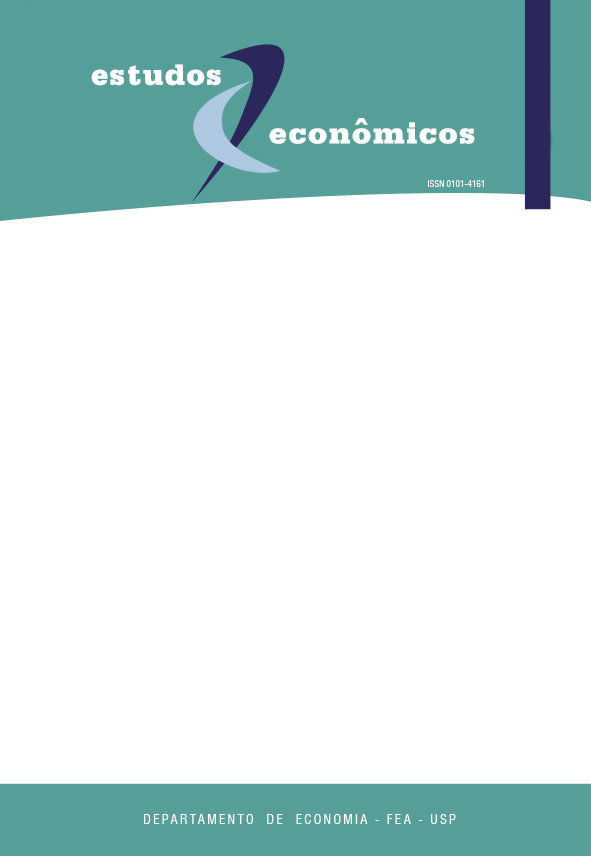Taxa de juros e default em mercados de empréstimos colateralizados
DOI:
https://doi.org/10.1590/S0101-41612011000400002Keywords:
default probability, incomplete markets, survival analysisAbstract
This paper investigates how changes in interest rates affect the probability of default (PD) in a general equilibrium model with incomplete markets and collateral requirement. Theoretically, the PD has a positive relationship with the loan real interest rate and negative with the economy real interest rate. Empirically, those relationships are confirmed by the estimation of the Cox proportional hazard model for a large sample of collateralized loans. Among the control variables, there are characteristics of the individuals, contracts, and economy as a whole. Intuitively, a lower real interest rate reduces earnings from financial operations, leading the banks to increase their credit portfolios by lending for riskier individuals.
Downloads
References
Andreeva, G. (2006) European generic scoring models using survival analysis. Journal of the Operational Research Society, v. 57, p. 1180-1187.
Banasik, J., Crook, J., Thomas, L. (1999) Not if but when will borrowers default. Journal of the Operational Research Society, v. 50, p. 1185-1190.
Barth, J., Gotur, P., Neela, M., Yezer, A. (1983) The effect of government regulations of Personal Loans Markets: A Tobit Estimation on Microeconomic Model. Journal of Finance, v. 38, p. 1233-1251.
Bellotti, T., Crook, J. (2007) Credit Scoring With Macroeconomic Variables Using Survival Analysis. University of Edinburgh Working Paper.
Breslow, N. (1972) Contribuição à discussão do artigo de D. R. Cox. Journal of the Royal Statistical Society B, v. 34, p. 216-217.
Carling, K., Jacobson, T., Linde, J., Roszbach, K. (2007) Corporate Credit Risk Modeling and the Macroeconomy. Journal of Banking and Finance, v. 31, p. 845-868.
Chu, V. (2001) Principais Fatores Macroeconômicos da Inadimplência Bancária no Brasil. Mimeo. Banco Central do Brasil.
Cox, (1972) Regression Models and Life Tables (with discussion). Journal of the Royal Statistical Society B, v. 34, p. 187-220.
Cox, (1975) Partial Likelihood. Biometrika, v. 62, p. 269-276.
Divino, J. A., Lima, E., Orrillo, J. (2010) Interest Rates and Default in Unsecured Loan Markets. 2010 World Congress of the Econometric Society.
Dubey, P., Geanakoplos, J., Shubik, M. (1990) Default and Efficiency in a General Equilibrium Model with Incomplete Markets. Cowles Foundation Discussion Paper nº 773R.
Dubey, P., Geanakoplos, J., Zame, W. (1995) Default, Collateral and Derivatives. Mimeo. Yale University.
Dubey, P., Geanakoplos, J., Shubik, M. (2005) Default and Punishment in General Equilibrium. Econometrica, v. 73, p. 1-37.
Lin, E., White, M. (2001) Bankruptcy and the Market Mortgage and Home Improvement Loans. Journal of Urban Economics, v. 50, p. 138-162.
Magill, M., Quinzii, M. (1996) Theory of Incomplete Markets. Cambridge: The MIT Press. 540 p.
Martins, M. S., Galli, O. C. (2007) A previsão de insolvência pelo modelo de Cox: Uma aplicação para a análise de risco de companhias abertas brasileiras. REAd - Edição 55, v. 13 Nº 1.
Pascoa, M. R., Seghir, A. (2009) Harsh default penalties lead to Ponzi schemes. Games and Economic Behavior, v. 65, p. 270-286.
Peto, R. (1972) Discussion of the paper by D. R. Cox. Journal of the Royal Statistical Society B, v. 34, p. 205-207.
Rocha, F. (1999) Previsão de Falência Bancária: um Modelo de Risco Proporcional. Pesquisa e Planejamento Econômico, v. 29, p. 137-152.
Stepanova, M., Thomas, L. (2001) PHAB Scores: Proportional Hazards Analysis Behavioural Scores. Journal of the Operational Research Society, v. 52, p. 1007-1016.
Stepanova, M., Thomas, L. (2002) Survival Analysis Methods for Personal Loan Data. Operations Research, v. 50, p. 277-289.
Tang, L., Thomas, L., Thomas, S., Bozzetto, J-F. (2007) It’s the Economy Stupid: Modelling Financial Product Purchases. International Journal of Bank Marketing, v. 25, p. 22-38.
Whalen, G. (1991) A Proportional Hazards Model of Bank Failure: An Examination of its Usefulness as an Early Warning Tool. Economic Review of the Federal Reserve Bank of Cleveland, v. 27, p. 21-31.
Zame, W. (1993) Efficiency and the Role of Default when Security Markets are Incomplete. American Economic Review, v. 83, p. 1142-1164.
Downloads
Published
Issue
Section
License
Copyright (c) 2011 Sergio Ricardo Faustino Batista, José Angelo Divino, Jaime Orrillo

This work is licensed under a Creative Commons Attribution-NonCommercial 4.0 International License.
By submitting an article, the author authorizes its publication and attests that it has not been submitted to any other journal. The original article is considered final. Articles selected for publication are proofread for grammatical and orthographic errors. The journal does not pay rights for published articles. The Institute of Economic Research from the School of Economics, Business and Accounting of the University of São Paulo (Instituto de Pesquisas Econômicas da Faculdade de Economia, Administração e Contabilidade da Universidade de São Paulo) owns the journal's copyright.




